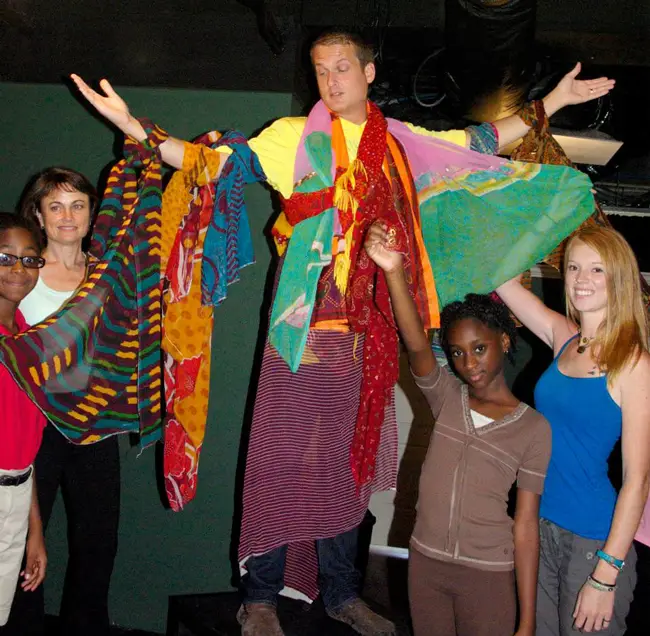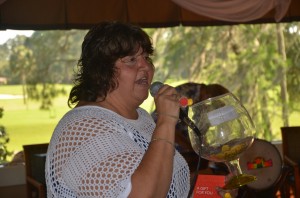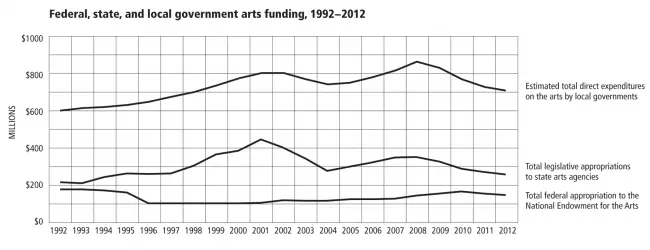
Speaking from both sides of the mouth is a specialty of Washington politicians. They made the point in the last few years regarding arts and education.
In 2010, the House of Representatives declared the second week of September National Arts in Education Week. A few weeks ago, the House Appropriations Committee took up the 2014 funding bill for the National Endowment for the Arts, one of the last remaining pipelines of federal dollars to the arts in education. The proposal calls for funding of no more than $75 million for the NEA, the lowest level since 1974, not counting the diminishing effects of inflation–and a lower level than during the mid-1990s, when the late Jesse Helms, the North Carolina senator, attempted to abolish the agency.
In 2012, the NEA got $146 million, down 6 percent from 2011. Local government funding for the arts had been increasing since 1992, peaking in 2008 at a combined $858 million nationwide. But it has decreased 18 percent since, going back down to 1998 levels, according to Grantmakers in the Arts, the public policy advocacy group and information clearinghouse on arts funding.
“This is an ominous time for those of us who care deeply about the arts in America,” Hillary Clinton once wrote in a New York Times op-ed. “A misguided, misinformed effort to eliminate public support for the arts not only threatens irrevocable damage to our cultural institutions but also to our sense of ourselves and what we stand for as a people.” That was 18 years ago, when the NEA was facing the threat of elimination. But even then, NEA funding, which had peaked at $174 million in 1993, survived, and was cut back to $99 million for the next several years.
In inflation-adjusted dollars, that’s the equivalent of $147 million today–almost exactly the funding the NEA received in 2012. In sum, it’s not getting better, and even local governments such as Palm Coast have been stingy with arts grants, awarding just $20,000 a year.
Nevertheless, local organizations have picked up the National Arts in Education Week banner under the leadership of Lisa McDevitt, the Flagler Auditorium director who also, four years ago, established an arts in education fund to support organizations and students showcase their talents.
The weeklong celebration of Arts in Education Week runs through Sept. 15, with support from the school district, the auditorium governing board, the Flagler County Chamber of Commerce and the Flagler County Tourist Development Council.
“We wanted to celebrate this designation in Flagler County, and have a great line up of activities planned to raise visibility for our local arts community,” McDevitt said.

The celebration began last Saturday with a Second Story Stage Workshop on “Audition Preparation” at the Flagler Playhouse. It continued Monday a free event at the Flagler Auditorium, with art work displays by the Flagler County Art League and the Flagler Fine Art Festivals, including Pat Fadden, Mike Gleason, Barbara Lindfors, Judy Matthews, Mike Murphy, Steven Sobel, Trish Vevera, and Judy Wormeck, and live performances by City Repertory Theatre, the Flagler Playhouse (it’ll be the first time that the two theater organizations will come that close to sharing a stage), the Flagler School of Dance and local singer Linda Cole. (See the art league’s September newsletter here.)
The rest of the week:
Sept. 10 – Celebrating Arts in the Schools; Flagler Auditorium, 6-8 pm. Showcase featuring local student performances in music, art, dance and drama. Free. Call 386-437-7547.
Sept. 11 – Arts day with Leadership Flagler. Flagler County Chamber of Commerce’s Leadership Class will meet with local arts groups including Flagler County Art League, Flagler Playhouse, Hollingsworth Gallery, City Repertory Theatre and Flagler Auditorium. Call 386-437-0106. www.
Sept. 13 – “Joseph and the Amazing Technicolor Dreamcoat,” City Repertory Theatre, 7:30 pm. The theater, located in City Marketplace in Palm Coast, kicks off its season with this lively musical with lyrics by Tim Rice and music by Andrew Lloyd Webber. The story is based on the “coat of many colors” story of Joseph from the Book of Genesis. $20 adults/$15 students. Call 386-585-9415. Visit http://crtpalmcoast.com/
Sept. 14 – Flagler County Art League/Hollingsworth Gallery “Second Saturday” event. 6-9 pm. FCAL and Hollingsworth Gallery, located in City Marketplace in Palm Coast join forces each month for art show openings at their galleries. City Repertory Theatre presents a special performance of “Joseph and the Amazing Technicolor Dreamcoat” at 9 pm. Gallery openings free; tickets needed for performance. Call386-986-4668 or visit www.
Sept. 15 – Flagler Fine Art Festivals, Veterans Park, Flagler Beach, 10 am – 4 pm. Featuring the best in juried regional fine art — a selection to suit every collector — plus performing artists, artist demonstrations and a children’s art project sponsored by Michael’s of Palm Coast. Free. Call 386-986-9567 or visit www.flaglerfineartfest.
Sept. 15 – “Joseph and the Amazing Technicolor Dreamcoat” matinee performance, City Repertory Theatre, 2 pm. The theatre, located in City Marketplace in Palm Coast, kicks off its season with this lively musical. $20 adults/$15 students. Call (386) 585-9415. Visit http://crtpalmcoast.com.
![]()
Arts for Our Sake
Hillary Clinton’s 1995 Op-Ed on the Arts in Education (The New York Times)
This is an ominous time for those of us who care deeply about the arts in America. A misguided, misinformed effort to eliminate public support for the arts not only threatens irrevocable damage to our cultural institutions but also to our sense of ourselves and what we stand for as a people.
One of the great successes of the arts in America is that they are not the preserve of any “cultural elite.” Through museums, libraries, schools, dance companies and concerts, the arts are truly part of the public domain, accessible to all and capable of encouraging every person’s artistic expression and sensibility.

The President has shown that we can balance the budget over the next 10 years without undermining our commitment to the arts. The N.E.A. budget accounts for less than 0.02 percent of the Federal budget. Eliminating this small but vital agency would have grave consequences for local economies. Federal support for the arts helps attract tourists, stimulate business, expand the tax base and improve the quality of life — a huge return on a small investment.
Despite a 30-year bipartisan commitment to the arts, there are those who argue that public support is a luxury we can no longer afford. They mistakenly suggest that the arts are enjoyed only by a small, wealthy minority. But if public support for the arts disappears, those most affected will not be the richest Americans but the millions of citizens who rely on the N.E.A. to bring the arts to their local schools and communities.
I find it ironic that those who talk the loudest about America’s loss of civility, character and values (particularly those arising from Western civilization) are often the first to recommend obliterating the agencies responsible for promoting arts programs that make Sophocles, Shakespeare, Mozart and O’Keefe available to our children.
They fail to appreciate what every generation of Americans has intuitively known — that the artistic imagination is critical to our civilization and our democracy. They forget the prescient words of John Adams: “I must study politics and war that my sons may have liberty to study mathematics and philosophy. My sons ought to study mathematics and philosophy . . . in order to give their children a right to study painting, poetry, music.”
The power of the arts is not simply to provide pleasant esthetics but to help move us forward as a democracy. Human expression, as conveyed through the arts, enables us to understand better the complexities of life and gives us a bridge to the world preceding and surrounding us. Most important, exposure to our cultural traditions enriches the lives of our children.
Too often, we see children who, instead of discovering the joys of painting, music, sculpting or writing, express themselves through acts of frustration and even violence. The arts offer an alternative to the more disturbing elements of our popular culture, and a safe haven that allows children to explore their creative potential, transporting them beyond the bounds of their difficult circumstances. Their exposure to the roots and diverse richness of human civilization will enhance their understanding of their own heritage and the world in which they live.
Clearly our nation faces difficult choices. But as the rhetoric heats up over the role of government in our society, I hope we will remember that public support for the arts is a down payment on our future. It is an investment in the values we claim to honor and in the cultural traditions in which democracy has flourished for 218 years. Now is no time to turn our backs on that legacy or its promise.






























Leave a Reply